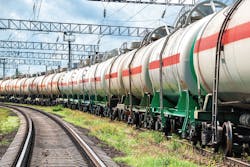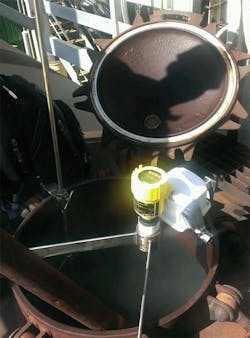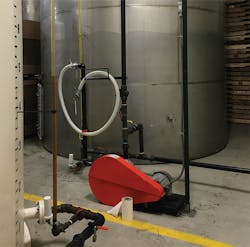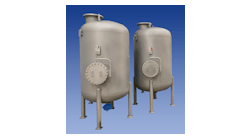The advantages of wireless tank level monitoring systems
Food manufacturing facilities, agricultural farms, chemical plants and other industrial plants use tanks and silos to store necessary processing ingredients or end product. These steel storage vaults are monitored for various reasons, most notably for inventory control and safety.
Monitoring tanks and silos is often challenging. Sometimes containing hazardous materials or being situated in inconvenient and remote locations, these storage chambers pose potential dangers and difficulties when checking and controlling assets. Even as wired sensor systems replace manual methods for tank monitoring, cabling requirements, environmental conditions, multiple sensing requirements and topography can present challenges.
Advantages of wireless tank level monitoring systems
Wireless sensor control systems offer many advantages over wired systems that can improve operational efficiency in monitoring tanks and silos while reducing costs. More cost-effective and versatile than traditional manual gauges and wired instrumentation, wireless telemetry systems meet challenges that wired systems cannot address. In fact, tank level monitoring is perhaps the most universal application optimized through wireless sensor networks.
For example, powered by battery, solar or local power, a wireless remote monitoring system has no conduit requirements, eliminating the need for hardwiring instrumentation that can be expensive if connections are thousands of feet away from endpoints. Wires also can restrict operation on certain topographies. As wireless remote monitoring systems use radio transmissions, signals are sustainable through different terrain, structures, or weather. Even when operating in hostile and dangerous environments, a wireless sensor control system can run unattended for years without being affected by environmental conditions such as snow, rain, dust storms and ice. After initial installation, adding or subtracting sensors to measure parameters such as pressure, temperature and level is easy.
Versatile applications addressed by wired systems
While known throughout the oil and gas industry for providing a reliable and cost-effective solution for monitoring tank farms, wireless remote sensor solutions are growing in use in other industries such as regeneration facilities, food processing plants and even agricultural farms to optimize operations associated with tank level monitoring.
For instance, a regeneration facility increased worker safety and efficiency by automating measurement of hazardous liquids in rail cars with a wireless sensor control system. On a daily basis, a refinery ships several sulfuric acid rail cars to a load regeneration facility. Technicians would manually measure the level of each rail car with a tank measurement stick, exposing themselves to acid fumes. As a manual method, tank measurement by stick varied in accuracy, dependent on the operator. The procedure was also time-consuming and laborious, requiring that an operator make as many as eight to 10 trips to the rail car sites to verify tank levels during an eight-hour shift.
Reducing the risk of sulfuric acid exposure to technicians, a radar tank sensor now measures the level of the sulfuric acid in rail cars. A wireless remote monitoring system (see Image 2) integrates with the sensor, sending data to a gateway where it becomes available for download into a computer or programmable logic controller (PLC). Technicians now only need to place a radar sensor inside the tank when first opened and remove it when the tank is full of spent acid.
Food manufacturing facilities are also optimizing tank level monitoring operations using wireless sensor control systems. In one scenario, a manufacturer of tortilla products automated the manual measurement of cooking oil stored in tanks located outside its factory. Managing oil levels in tanks is important to determine when to order new supplies of cooking oil and dispose of the wasted stock. In the past, operators used sight gauges to estimate tank volumes. Manual estimating was not an accurate science and required frequent follow-up to stay current on tank levels.
By implementing a wireless sensor control system, the tortilla manufacturer automated the tank level monitoring process, eliminating requirements for repeated manual measurements of cooking oil. In addition, when levels met a threshold, the telemetry system automatically generated an email to an appropriate vendor to reorder a standard delivery volume of virgin oil or to remove a fixed amount of used oil when reaching a programmed threshold (see Image 3).
Connecting farm operations with wireless monitoring systems
Farms looking to operate more efficiently and smarter in pursuit of greater profitability are replacing manual methods with automated processes to collect data on silo operating parameters for on-demand access by farm workers and/or download into analytics software for better asset management.
Data capture on many farms is still very labor intensive, with farmhands regularly traveling to silos located in different areas of the farm to manually gauge instrumentation. To maintain silo status, workers need to collect data from silos several times a day. For a small farm, that can mean monitoring assets over 300 to 500 acres, 1,500 to 2,500 acres for a medium-to-large farm, and 5,000 to 10,000 acres for a “mega” farm.
A wireless asset monitoring and control system can concurrently monitor grain levels, silo temperatures and other parameters with multiple sensors without cabling requirements or multiple interfaces. Instrumentation installed within silos connect to radio nodes that power and extract data from the sensors via radio transmission to a gateway that serves as the central processing hub. The gateway formats and then delivers data to a PLC in a control center. In some configurations, an Ethernet interface module connects to the gateway to tie information into either a local Wi-Fi network for local access or a modem that connects the internet and a cloud service provider so that data is accessible across a co-op or shared with a supplier or a customer. Farm operators can access data on temperature and grain usage through the convenience of their laptops and even smartphones using their cloud service.
By automating silo monitoring activities, farmhands will know when they need to switch to another silo or refill the measured silo. As a result, the farmer increases production efficiency as well as gains true transparency over operations by receiving a constant status on silos.
Available in a variety of configurations, wireless control systems offer cost-effective solutions for a variety of tank level monitoring applications. More cost effective, versatile and often safer than traditional manual gauges and wired instrumentation, wireless control systems meet different challenges for tank level monitoring that other technologies can’t address. They can operate in remote locations, interface with a variety of sensors and are less susceptible to lightning strikes that can destroy a wired control system. In retrofit applications, savings can be substantial.
Josh Schadel serves as director of engineering at SignalFire Wireless Telemetry responsible for new product development. With more than 15 years of experience in high-tech instrumentation, he has a strong background in embedded systems and PCB designs as well as sensor networks. He may be contacted at [email protected].




